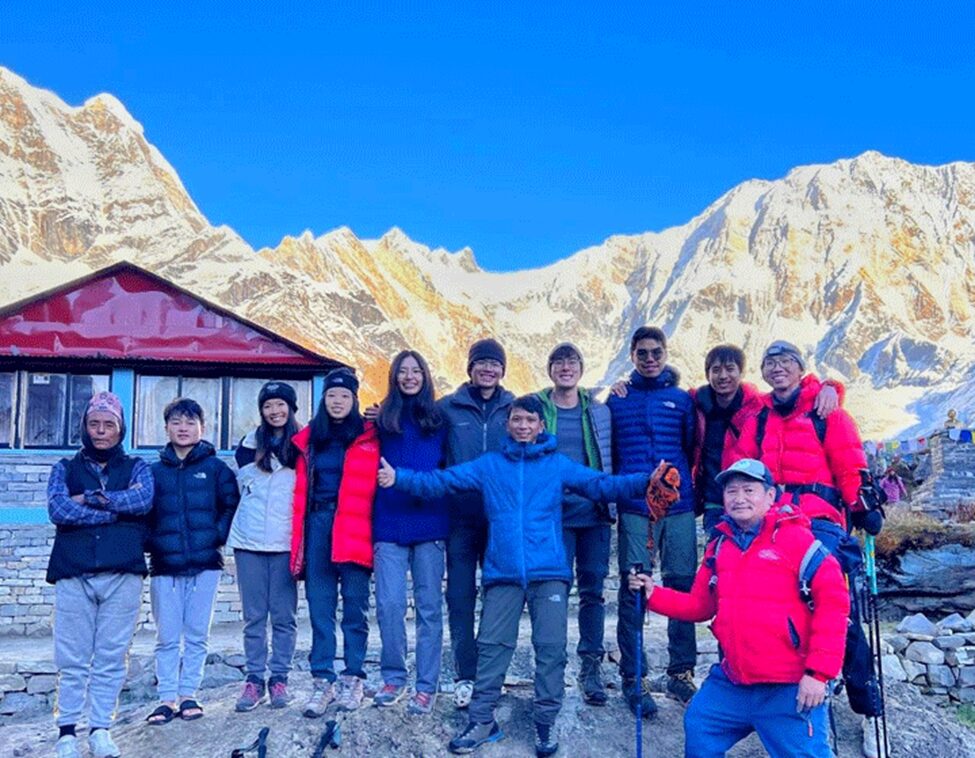
Trekking in Nepal is not fair, almost overcoming peaks—it’s a significant trip into old societies, breathtaking scenes, and internal change. Among Nepal’s numerous trekking goals, the Annapurna region stands out for its openness, differences, and sheer magnificence. Whether you’re a tenderfoot looking for a brief but beautiful path or an experienced explorer needing to navigate tall mountain passes and farther valleys, the Annapurna region has something for everyone.
This guide takes you through four famous treks in the Annapurna region: the Annapurna Base Camp Hike, the Mardi Himal trek (4 days), the Ghorepani Poon Hill trek (5 days), and the Annapurna Circuit trek with Tilicho Lake. Each path offers a special focal point through which to encounter the glory of the Himalayas.
Annapurna Base Camp Hike:
The Annapurna Base Camp Hike is one of the most well known treks in Nepal—and for great reason. It leads you straight into the heart of the Annapurna Asylum, a normal amphitheater of towering peaks counting Annapurna I (8,091m), Hiunchuli, Machapuchare (Fishtail), and Annapurna South.
Why Select This Trek?
Unlike numerous high-altitude Adventure, the ABC trek is moderately brief and guide in trouble. It begins from Pokhara, slowly rising through terraced farmlands, rhododendron timberlands, and elevated knolls. Along the way, you’ll pass through Gurung and Magar towns like Chhomrong, Sinuwa, and Bamboo, where warm neighborliness is standing by in cozy teahouses.
The highlight, of course, is coming to Annapurna Base Camp (4,130m). Standing at the base of a few of the world’s most noteworthy mountains, encompassed by sparkling icy masses and frigid towers, is an awe-inspiring experience.
Trek Overview
Duration: 7–11 days
Max Height: 4,130m
Difficulty: Moderate
Best Time: March–May, September–November
This trek is culminated for explorers who need an immersive Himalayan encounter without greatly tall elevations or long time commitments.
Mardi Himal trek (4 Days):
If you’re brief on time but still dream of all encompassing Himalayan seas and serene trails, the Mardi Himal trek 4 days is your culminating elude. Tucked between the Annapurna Base Camp course and the Machapuchare ridgeline, this path is less traveled and refreshingly wild.
Why Select This Trek?
In four days, you hill from thick woodland trails to windswept ridgelines with unparalleled views of Machapuchare, Annapurna South, and Hiunchuli. The path starts from Kande or Phedi, passing through lavish timberlands filled with rhododendrons and moss-covered trees.
By the time you reach Tall Camp (3,580m) and proceed to the Mardi Himal Perspective (4,200m), you’ll feel like you’re drifting over the clouds. The confinement, the close-up mountain views, and the changing view in such a brief time make this trek genuinely special.
Trek Overview
Duration: 4 days
Max Height: 4,200m
Difficulty: Moderate
Best Time: March–May, September–December
The Mardi Himal trek is perfect for travelers looking for a brief, off-the-beaten-path enterprise with jaw-dropping scenery.
Ghorepani Poon hill trek- 5 Days:
The Ghorepani Poon hill trek is a classic brief trek in the Annapurna region that culminates for tenderfoots, families, or anybody looking for an excellent hilling involvement with lower height and extraordinary sees. The crown gem of this trek is the dawn scene from Poon hill (3,210m)—a sea so dazzling it clears out trekkers speechless.
Why Select This Trek?
This path offers a social and picturesque devour. Beginning from Nayapul or Tikhedhunga, you climb through charming towns, suspension bridges, and timberlands filled with blooming rhododendrons in spring. Ghorepani, the key town en course, is a pleasant rest park some time recently on the early morning hill to Poon Hill.
From this perspective, you’ll be welcomed by an epic scene of Dhaulagiri (8,167m), Annapurna I, Machapuchare, and Nilgiri—all lit up in brilliant tones as the sun rises.
Trek Overview
Duration: 5 days
Max Height: 3,210m
Difficulty: Simple to Moderate
Best Time: Year-round, but top monsoon
This trek is amazing for those with constrained time or less trekking encounters, advertising wealthy rewards with negligible difficulty.
Annapurna Circuit trek with Tilicho Lake:
The Annapurna Circuit is frequently respected as one of the world’s most prominent trekking courses. When combining Annapurna Circuit trek with Tilicho Lake (4,919m)—the most noteworthy lake of its measure in the world—the involvement gets to be nothing short of legendary.
Why Select This Trek?
This trek is a long, gutsy circle around the Annapurna Massif, starting in the subtropical marshes of Besisahar and hilling continuously through the Marshyangdi Waterway valley, past waterfalls, timberlands, and antiquated towns like Chame and Manang.
After acclimatizing in Manang, you depart to Tilicho Lake, a strange turquoise frosty lake encompassed by sheer cliffs and frosty mammoths. Rejoining the primary path, you at that point cross the Thorong La Pass (5,416m)—the most noteworthy point of the trek—before slipping into the sacrosanct valley of Muktinath.
The scenes continually move, from rich farmland to snow capped tundra to bone-dry, desert-like landscape in Colt. The social differing qualities are fair as surprising, with experiences extending from Hindu communities to Tibetan Buddhist settlements.
Trek Overview
Duration: 16–21 days
Max Elevation: 5,416m (Thorong La), 4,919m (Tilicho Lake)
Difficulty: Challenging
Best Time: March–May, September–November
For those looking for a transformative and physically requesting travel, the Annapurna Circuit with Tilicho Lake is a ceremony of passage.
Why Select the Annapurna Region?
Accessibility
Unlike Everest or inaccessible western regions, most Annapurna treks start inside a few hours’ drive from Pokhara, which is effortlessly open by street or flight from Kathmandu.
Variety in Length and Difficulty
From a brief 4-day trek to a 3-week circuit, the region caters to all sorts of trekkers. Whether you need a fast end of the week hill or a high-altitude undertaking, Annapurna has a course for you.
Cultural Richness
The trails pass through Gurung, Magar, Thakali, and Tibetan towns, where conventional ways of life stay intact. Cloisters, chortens, supplication banners, and nearby neighborliness enhance the travel past the physical trek.
Teahouse Comfort
One of the best things about trekking in the Annapurna region is the well-developed teahouse foundation. You’ll discover warm suppers, hot showers, and comfortable beds in each town, making it perfect for those who favor not to camp.
Scenic Diversity
No other region in Nepal offers such an extent of scenery—from terraced ranches and bamboo woodlands to frosty valleys, high-altitude deserts, and snow-capped peaks.
Best Time for Annapurna region Treks
The ideal seasons are:
Spring (March–May): Warm climate, rhododendrons in full bloom.
Autumn (September–November): Clear skies, extraordinary perceivability, steady weather.
Winter (December–February) can be calm and picturesque but comes with colder temperatures and conceivable snow-blocked passes. Storm (June–August) is rich but sloppy, with decreased perceivability and leeches on lower trails.
Essential Trekking Tips
Pack Layers: Climate can alter rapidly, particularly at higher elevations.
Stay Hydrated: Carry refinement tablets or a water filter.
Hire Neighborhood Guides/Porters: For security, route, and supporting the neighborhood economy.
Acclimatize Appropriately: Particularly vital on high-altitude treks like ABC and the Annapurna Circuit.
Respect Neighborhood Culture: Dress humbly, inquire some time recently taking photographs, and take after town customs.
Practical Data for Annapurna region Treks
Permits Required
- TIMS Card (Trekkers’ Data Administration System)
- ACAP Allow (Annapurna Preservation Range Project)
- For the Annapurna Circuit with Tilicho Lake, all the over plus:
- Restricted Range Allow if entering from Nar Phu (discretionary extension)
Accommodation
All these treks are upheld by teahouse lodges advertising essential convenience, hot suppers, and warm beds. You do not require to camp or carry nourishment, making trekking more available and affordable.
Weather Considerations
- Spring (March–May): Sprouting blooms, guide weather
- Autumn (September–November): Clear skies, best views
- Winter (December–February): Cold but calm trails, particularly for lower-altitude treks
- Monsoon (June–August): Damp, sloppy trails, not perfect for tall passes
Altitude Tips
While treks like Ghorepani and Mardi Himal include lower elevations, the Annapurna Base Camp and particularly the Annapurna Circuit go well over 4,000m. Continuously Hike continuously, hydrate well, and permit time for acclimatization.
Gear Checklist
- Layered clothing (base, downy, down, waterproof)
- Trekking boots and socks
- Headlamp, shades, sunscreen
- Sleeping sack (can be leased in Pokhara or Kathmandu)
- Reusable water bottles and decontamination tablets
Final Words
Trekking in the Annapurna region is more than a physical trek—it’s a window into the Himalayas’ soul. Whether you wake up to the brilliant shine of dawn at Poon hill, stand face-to-face with Annapurna I at base camp, investigate the serene ridgelines of Mardi Himal, or cross the frosty region of Thorong La after going by Tilicho Lake, these encounters remain with you for life.
No matter which trek you select, the Annapurna region guarantees breathtaking scenes, inviting societies, and a profound association to nature. All you have to do is take that to begin with.
FAQs:
1. Do I require a guide for these treks?
While solo trekking is permitted in most Annapurna courses, having a guide is profoundly prescribed for security, social knowledge, and navigation—especially for the Annapurna Circuit with Tilicho Lake.
2. How fit do I require to be?
A guide level of wellness is sufficient for Ghorepani and Mardi Himal, whereas ABC and Annapurna Circuit require more continuance and arrangement, particularly for longer hills and higher elevations.
3. Can I do these treks in winter?
Yes, but with caution. Lower-altitude treks like Ghorepani are appropriate in winter, but tall passes like Thorong La can be snow-blocked and dangerous.
4. Is a web or versatile flag accessible on the trek?
Most towns offer Wi-Fi or versatile flags, particularly on well known courses like ABC and Ghorepani. In any case, the network gets to be restricted at higher elevations like Tilicho Base Camp and Thorong La.
5. What makes the Annapurna region distinctive from Everest?
The Annapurna region offers more prominent differences in view, lower costs, shorter get to from Pokhara, and an assortment of trek lengths—from brief 4-day hills to epic 3-week adventures.
